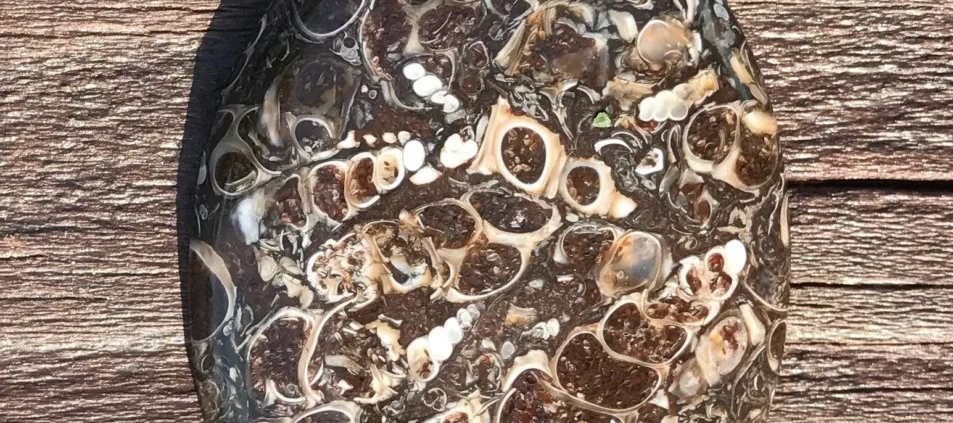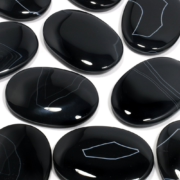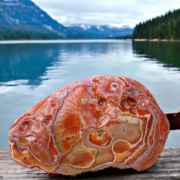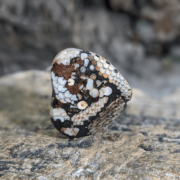Fossil Agate
Fossil agate is a unique type of agate that contains fossilized remains within its structure. Agate itself is a type of chalcedony, which is a variety of quartz known for its banded patterns and vibrant colors. Fossil agate forms when agate is deposited in layers over ancient organic material such as plants, shells, or even bones. Over time, the organic material decays, leaving behind voids or cavities within the agate. These voids are then often filled with minerals, preserving the impression of the original organic material in the agate. The result is a stunning gemstone that showcases the intricate patterns of the agate alongside the fossilized remains, providing a fascinating glimpse into the Earth’s ancient history. Fossil agate is prized by collectors and enthusiasts alike for its beauty and its ability to tell the story of life millions of years ago.
 64mm Colus Fossil Agate Cabochon AAA Museum Grade 187ct 64 by 44 by 8mm Online in India – Etsy
64mm Colus Fossil Agate Cabochon AAA Museum Grade 187ct 64 by 44 by 8mm Online in India – Etsy
Contents
- Importance and significance in geology and jewelry
- Formation process of fossil agate
- Types and Varieties
- Location and Distribution
- Identification and Characteristics
- Uses and Applications
Importance and significance in geology and jewelry
Fossil agate holds significant importance in both geology and jewelry, each field benefiting from its unique characteristics and fascinating history:
- Geological Significance:
- Paleontological Insight: Fossil agate provides valuable insights into ancient ecosystems and past environments. The fossilized inclusions within the agate preserve evidence of prehistoric plants, animals, and marine life, offering clues about past climates, habitats, and biodiversity.
- Stratigraphic Information: Fossil agate can help geologists understand the geological processes that occurred during its formation. The presence of fossilized material within agate indicates specific sedimentary environments and depositional conditions, aiding in the interpretation of stratigraphic sequences and sedimentary facies.
- Dating and Correlation: By analyzing the fossil inclusions and their associated geological context, scientists can establish relative ages and correlations between different rock layers and formations. Fossil agate can serve as markers for dating sedimentary deposits and reconstructing geological histories.
- Tectonic and Environmental Changes: Studying fossil agate formations can provide insights into past tectonic events, climate fluctuations, and environmental changes. The distribution and composition of fossil agate deposits reflect the dynamic interplay between geological, biological, and environmental factors over millions of years.
- Jewelry and Aesthetics:
- Unique Aesthetic Appeal: Fossil agate’s combination of vibrant colors, intricate patterns, and fossilized inclusions make it highly desirable for jewelry making. Each piece of fossil agate is unique, showcasing the beauty of natural processes and the passage of time.
- Historical and Cultural Significance: Fossil agate has been valued for centuries as a decorative gemstone and a symbol of prestige and status. In many cultures, agate is associated with healing, protection, and spiritual beliefs. Fossil agate, with its fossilized inclusions, adds an additional layer of significance, connecting wearers to the Earth’s ancient history.
- Collectibility and Rarity: High-quality fossil agate specimens are prized by collectors for their rarity and aesthetic appeal. Collectors may seek out specimens with exceptional fossil inclusions, unique patterns, or unusual color combinations. Fossil agate specimens with well-preserved fossils or rare species can command high prices in the gemstone market.
- Artistic Expression: Jewelry designers and lapidaries often use fossil agate as a medium for artistic expression. The unique patterns and textures of fossil agate inspire creative designs, from delicate cabochon settings to bold statement pieces. Fossil agate jewelry allows wearers to celebrate the beauty of nature and the marvels of Earth’s ancient past.
In summary, fossil agate holds dual significance in geology and jewelry, serving as both a scientific tool for understanding Earth’s history and a cherished gemstone for adornment and artistic expression. Its timeless beauty and geological story continue to captivate scientists, collectors, and jewelry enthusiasts alike.
Formation process of fossil agate

The formation process of fossil agate is a fascinating geological phenomenon that occurs over millions of years. Here’s a step-by-step explanation of how fossil agate forms:
- Initial Deposition: It all begins with the deposition of silica-rich solutions in cavities or cracks within rocks. These solutions often contain dissolved silica, which is the primary component of agate.
- Formation of Agate: Over time, the silica-rich solutions slowly crystallize and form layers of agate within the cavities. Agate is a variety of chalcedony, which is a type of microcrystalline quartz. As the silica crystallizes, it forms bands or layers of different colors and textures, creating the characteristic banded patterns of agate.
- Incorporation of Organic Material: In some cases, during the formation of agate, organic material such as plant matter, shells, or even bones may become trapped within the cavities. This organic material may be present in the surrounding sedimentary rocks or may have fallen into the cavities after the agate formation began.
- Decay of Organic Material: Over time, the organic material within the agate cavity decays and decomposes. This process can take millions of years and is influenced by factors such as temperature, pressure, and the presence of microorganisms.
- Formation of Voids: As the organic material decays, it leaves behind voids or cavities within the agate. These voids may retain the shape or impression of the original organic material.
- Mineralization: The voids left by the decay of organic material may then be filled with secondary minerals, such as quartz, calcite, or other mineral deposits. These minerals often form crystals or aggregates that fill the voids and preserve the shape of the original organic material.
- Agate and Fossil Integration: The secondary minerals that fill the voids become integrated with the surrounding agate, creating a seamless transition between the fossilized material and the agate matrix.
- Final Preservation: The fossil agate continues to undergo geological processes such as erosion, sedimentation, and tectonic activity. Eventually, it may be exposed at the Earth’s surface through natural processes such as weathering or human activities such as mining.
The result is a stunning gemstone that showcases the intricate patterns of the agate alongside the fossilized remains, providing a unique and beautiful window into the Earth’s ancient history.
Types and Varieties

Fossil agate, like traditional agate, comes in a variety of types and varieties, each with its own unique characteristics. Here are some common types and varieties of fossil agate:
- Plant Fossil Agate: This type of fossil agate contains preserved plant material within its structure. The plant material may include leaves, stems, or other parts of ancient vegetation. Plant fossil agate often showcases intricate patterns and textures that resemble the original plant material.
- Shell Fossil Agate: Shell fossil agate contains fossilized shells or shell fragments embedded within the agate matrix. These shells may belong to various marine organisms such as mollusks or crustaceans. Shell fossil agate often displays the distinctive shapes and textures of the original shells.
- Bone Fossil Agate: Bone fossil agate features fossilized bones or bone fragments preserved within the agate. These bones may belong to prehistoric animals such as dinosaurs, mammals, or reptiles. Bone fossil agate can provide valuable insights into ancient ecosystems and the evolution of life on Earth.
- Coral Fossil Agate: Coral fossil agate contains fossilized coral structures within the agate matrix. These structures may include coral branches, colonies, or individual coral polyps. Coral fossil agate often exhibits intricate patterns and vibrant colors reminiscent of living coral reefs.
- Insect Fossil Agate: Insect fossil agate contains fossilized insects or insect fragments trapped within the agate. These insects may include beetles, flies, or other arthropods. Insect fossil agate can offer valuable clues about ancient insect species and their behavior.
- Mixed Fossil Agate: Mixed fossil agate may contain a combination of different types of fossils, such as plant material, shells, bones, and insects, all preserved within the agate matrix. Mixed fossil agate showcases a diverse array of fossilized remains and can be particularly intriguing for collectors and enthusiasts.
These are just a few examples of the types and varieties of fossil agate that can be found. Each piece of fossil agate is unique, reflecting the specific geological conditions and processes that led to its formation, as well as the particular type of fossilized material it contains.
Location and Distribution

Fossil agate can be found in various locations around the world, often in regions with a rich geological history and abundant fossil deposits. Some of the notable locations and regions where fossil agate is found include:
- Western United States: States such as Oregon, Washington, Idaho, and Wyoming are known for their abundant agate deposits, including fossil agate. The Columbia River Basin in Oregon and Washington, in particular, is famous for producing fossil agate with plant and shell fossils.
- Morocco: Morocco is renowned for its rich deposits of agate, including fossil agate. Fossil agate specimens from Morocco often contain beautifully preserved plant and shell fossils, and they are highly prized by collectors.
- Brazil: Brazil is another significant source of agate, including fossil agate. Brazilian agate deposits can be found in various regions, such as Rio Grande do Sul and Minas Gerais. Fossil agate specimens from Brazil may contain a variety of fossilized material, including plants, shells, and corals.
- Madagascar: Madagascar is known for its diverse range of gemstones and minerals, including agate. Fossil agate specimens from Madagascar can contain a variety of fossilized material, and they are valued for their unique colors and patterns.
- Germany: Germany has been a traditional source of agate for centuries. The region of Idar-Oberstein in southwestern Germany has historically been famous for its agate mines, producing high-quality agate specimens, including fossil agate.
- Other Regions: Fossil agate can also be found in other parts of the world, including Australia, Mexico, India, and Indonesia, among others. Each region may produce fossil agate specimens with distinct characteristics based on the types of fossils preserved and the geological processes involved.
Overall, fossil agate can be found in various locations globally, and its distribution is often associated with regions with a history of volcanic activity, sedimentary deposits, and fossil-rich strata. Hobbyists, collectors, and lapidaries often seek out these unique specimens for their beauty and the fascinating stories they tell about Earth’s ancient past.
Identification and Characteristics

Identifying fossil agate involves recognizing both its agate characteristics and the fossilized inclusions it contains. Here are some key identification features and characteristics:
- Agate Characteristics:
- Banded Patterns: Fossil agate typically displays banded patterns of different colors and textures, characteristic of agate.
- Translucency: Agate is often translucent to semi-translucent, allowing light to pass through to varying degrees.
- Microcrystalline Structure: Agate has a microcrystalline structure, meaning its crystals are too small to be seen with the naked eye.
- Hardness: Agate has a hardness of 6.5 to 7 on the Mohs scale, making it relatively durable.
- Conchoidal Fracture: When broken, agate exhibits a smooth, curved fracture surface known as conchoidal fracture.
- Fossil Inclusions:
- Plant Material: Fossilized leaves, stems, or other plant parts may be visible within the agate.
- Shells: Fossilized shells or shell fragments may be embedded in the agate, displaying characteristic shapes and textures.
- Bones: Fossilized bones or bone fragments from prehistoric animals may be preserved within the agate.
- Coral: Fossilized coral structures, such as branches or polyps, may be present in the agate.
- Insects: Fossilized insects or insect parts, such as wings or exoskeletons, may be trapped within the agate.
- Color and Texture:
- Fossil agate can display a wide range of colors, including earth tones, blues, greens, and reds, depending on the minerals present and the conditions during formation.
- The texture of fossil agate may vary from smooth to slightly rough, depending on factors such as the size and distribution of crystals within the agate.
- Patterns and Arrangements:
- The arrangement and distribution of fossil inclusions within the agate can vary, resulting in unique patterns and configurations.
- Fossilized material may be distributed in bands, clusters, or irregular patterns within the agate matrix.
- Lustre:
- Fossil agate may exhibit a vitreous (glassy) lustre when polished, enhancing its aesthetic appeal.
Identifying fossil agate requires careful observation of these characteristics, as well as consideration of the geological context in which the specimen was found. Consulting reference materials and seeking expertise from experienced collectors or geologists can also aid in accurate identification.
Uses and Applications
 Large Turritella Fossil Agate Beads Huge Freeform Irregular Focal Bead – Intrinsic Trading
Large Turritella Fossil Agate Beads Huge Freeform Irregular Focal Bead – Intrinsic Trading
Fossil agate, with its unique beauty and intriguing fossil inclusions, has several uses and applications:
- Jewelry: One of the most common uses of fossil agate is in jewelry making. Fossil agate specimens, when polished and cut into cabochons or beads, create stunning pieces of jewelry such as necklaces, pendants, earrings, and bracelets. The intricate patterns and fossil inclusions add a distinctive and captivating element to jewelry designs, appealing to collectors and enthusiasts alike.
- Ornamental Objects: Fossil agate is also utilized in the creation of ornamental objects and decorative items. Larger specimens of fossil agate, such as polished slabs or spheres, can be displayed as decorative pieces in homes, offices, or museums. These ornamental objects highlight the natural beauty and geological significance of fossil agate, serving as conversation starters and focal points in interior design.
- Collecting and Display: Fossil agate is highly sought after by collectors who appreciate its aesthetic appeal and scientific value. Collectors may acquire fossil agate specimens for their personal collections, seeking out rare or exceptional pieces with unique fossil inclusions or patterns. Displaying fossil agate specimens in collections allows enthusiasts to admire and study these remarkable geological treasures.
- Educational Purposes: Fossil agate specimens provide valuable educational opportunities for teaching about geology, paleontology, and natural history. They can be used in classroom settings, museums, and educational programs to illustrate concepts such as fossilization, sedimentary processes, and geological time scales. Fossil agate specimens offer tangible examples of Earth’s ancient past, helping to engage students and foster a deeper understanding of geological phenomena.
- Healing and Metaphysical Properties: In some holistic healing practices and belief systems, agate is believed to possess metaphysical properties that promote balance, stability, and grounding. Fossil agate, with its fossilized inclusions, may be valued for its connection to ancient life forms and the Earth’s natural history. Some individuals may use fossil agate in meditation, energy work, or as decorative talismans, attributing symbolic meanings to its unique characteristics.
Overall, fossil agate serves both aesthetic and practical purposes, appealing to a wide range of individuals interested in gemstones, fossils, geology, and natural history. Whether used for jewelry, decoration, education, or spiritual practices, fossil agate continues to captivate and inspire people with its timeless beauty and fascinating origins.






Leave a Reply
Want to join the discussion?Feel free to contribute!